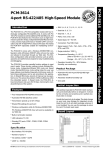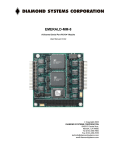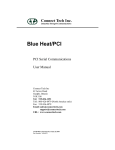Download Advantech PCL-849 Specifications
Transcript
PCL-849 4-Port RS-232 Interface Card Copyright Notice This documentation and the software included with this product are copyrighted 2001 by Advantech Co., Ltd. All rights are reserved. Advantech Co., Ltd. reserves the right to make improvements to the products described in this manual at any time without notice. No part of this manual or software may be reproduced, copied, translated or transmitted, in any form or by any means without the prior written permission of Advantech Co., Ltd. Information provided in this manual is intended to be accurate and reliable. However, Advantech Co., Ltd. assumes no responsibility for its use, nor for any infringements of rights of third parties which may result from its use. Acknowledgments PC-LabCard is a trademark of Advantech Co., Ltd. IBM, PC and PC/XT/AT are trademarks of International Business Machines Corporation. MS-DOS, MASM, QuickBASIC, Microsoft C and MSPASCAL are trademarks of Microsoft Corporation. Intel is a trademark of Intel Corporation. Turbo C and Turbo PASCAL are trademarks of Borland International. Part No. 2000084900 3rd Edition Printed in Taiwan May 2001 Contents Chapter 1: Introduction ....................................................... 5 Description ............................................................................. 6 Features .................................................................................. 7 Specifications ......................................................................... 7 Chapter 2: Hardware Installation ....................................... 11 Initial Inspection ................................................................. 12 Card Installation ................................................................. 13 Card Configuration ............................................................ 14 Default Settings ................................................................... 14 I/O Address and Interrupt Setup....................................... 14 Enhanced Mode .................................................................. 15 Speed Mode selection .......................................................... 20 Chapter 3: Software Installation ........................................ 21 Operating Environment Selection ..................................... 22 ICOM Utility Setup for Windows 95/98/NT Environments ...................................................................... 22 Chapter 4: Wiring .............................................................. 25 Connector Pin Assignments ............................................... 26 Wiring .................................................................................. 27 Chapter A: PC I/O Address Reference ................................ 29 PC I/O Address Usage ......................................................... 30 Chapter B: Quick Reference ............................................... 31 CHAPTER Introduction 1 Description The PCL-849 series are four port serial communication interface cards. Each port can be configured individually to RS-232 using onboard jumpers. PCL-849A/849B serial ports are implemented using 16C554 UARTs which make serial I/O more reliable. For higher performance, 16C654 UARTs can be installed in place of the 16C554 to create the PCL849+. By buffering data into 64-byte packets before putting it on the bus, UARTs drastically reduce the CPU load. This makes the PCL-849+ especially suitable for high-speed serial I/O applications under multitasking environments and for applications involving high data rates. PCL-849 series cards support two operating modes: standard mode and enhanced mode. In standard mode each of the four port addresses can be set individually. In enhanced mode, all four port addresses can be set automatically. The PCL-849+ also supports either shared IRQ or independent IRQ functions. When an on-board interrupt occurs the interrupt status register (vector address) indicates which port generated it. The shared interrupt can be set to most common (extended) AT interrupts. This simplifies programming, speeds interrupt processing and frees interrupts for other devices. 6 PCL-849 User's Manual Features v Four independent RS-232 serial ports v Transmission speeds up to 307.2 kbps v Independent I/O addresses and independent/shared IRQ settings for each of 4 serial ports v Wide IRQ selection: 3, 4, 5, 6, 7, 9, 10, 11, 12, 15 v Supports Standard DOS COM1, COM2, COM3, and COM4 v Supports DOS/Windows 3.1, Windows 95/98, Windows NT (ICOM Utility) v Supports surge protection: 3000 VDC (PCL-849B/849+) v LED indicators on each port indicate data flow v On-board interrupt status register for greater throughput v Complete RS-232 Modem-control signals Specifications · Bus interface: ISA · Number of ports: 4 · I/O address: 0x0200 ~ 0x03F8 · IRQ: 3, 4, 5, 6, 7, 9, 10, 11, 12, 15 · Data bits: 5, 6, 7, 8 · Stop bits: 1, 1.5, 2 · Parity: none, even, odd Chapter 1 Introduction 7 · UART: 1 × 16C554 (PCL-849A/849B) 1 × 16C654 (PCL-849+) · Speed: 50 ~ 921.6 kbps (PCL-849A) 50 ~ 307.2 kbps (PCL-849B/849+) · Connectors: 30-cm male DB-37 to 4 × DB25 male (DTE) · Data signals: TxD, RxD, RTS, CTS, DTR, DSR, DCD, RI, GND · Surge protection: 3000 VDC (PCL-849B/849+) · Power requirement: 250 mA typical 500 mA max. (+5 V), 70 mA typical. 120 mA max.(±12 V), · Dimensions: 185 mm × 98 mm · Operating Temperature.: 0 ~ 60° C (32 ~ 140° F) (refer to IEC-681.2.3 item) · Storage Temperature: -25 ~ 80° C (-13 ~ 176° F) · MTBF: over 135,000 hrs at 25° C, ground-fix environment · For technical support and service please visit our support website at: http://support.advantech.com and visit the "Industrial Automation Support" and "FAQ" sections. 8 PCL-849 User's Manual Chapter 1 Introduction Figure 1-1: Switch and jumper layout 9 10 PCL-849 User's Manual CHAPTER Hardware Installation 2 Initial Inspection Depending on the option you ordered, in addition to this manual, you should find the following items inside the shipping container: • PCL-849(A/B/+) 4-port RS-232 Card • One 30-cm male DB-37 to four male DB-25 cable • One diskette with ICOM utility software We have carefully inspected the PCL-849 mechanically and electrically before shipping. It should be free of marks and scratches and in perfect working order on receipt. As you unpack the PCL-849, check it for signs of shipping damage (damaged box, scratches, dents, etc.). If it is damaged or it fails to meet specifications, notify our service department or your local sales representative immediately. Also notify the carrier. Retain the shipping carton and packing material for inspection by the carrier. After inspection we will make arrangements to repair or replace the unit. Remove the PCL-849 from its protective packaging by grasping the rear metal panel. Keep the anti-vibration packing. Whenever you remove the card from the PC, store it in this package for protection. Warning! Discharge your body’s static electric charge by touching the back of the grounded chassis of the system unit (metal) before handling the board. You should avoid contact with materials that hold a static charge such as plastic, vinyl and styrofoam. Handle the board only by its edges to avoid static damage to its integrated circuits. Avoid touching the exposed circuit connectors. 12 PCL-849 User's Manual Card Installation Warning! Turn off your PC’s power supply whenever you install or remove the PCL-849 or its cables. Static electricity can easily damage computer equipment. Ground yourself by touching the chassis of the computer (metal) before you touch any boards. 1. Turn off the computer. Turn the power off to any peripheral devices (such as printers and monitors). 2. Disconnect the power cord and any other cables from the back of the computer. Turn the PC if necessary to gain access to the cables. 3. Remove the PC’s cover (refer to your user’s guide if necessary). 4. Locate the expansion slots or passive backplane (at the rear of the PC) and choose any unused slot. 5. Remove the screw that secures the expansion slot cover to the PC (save the screw to secure the interface card retaining bracket). Remove the anti-vibration card clamp if supplied. 6. Carefully grasp the upper edge of the PCL-849 card. Align the hole in the retaining bracket with the hole on top of the expansion slot. Align the gold striped edge connector with the expansion slot socket. Press the board firmly into the socket. 7. Replace the screw in the expansion slot retaining bracket. Replace anti-vibration card holder. 8. Replace the PC’s cover. Connect the cables you removed in step 2. 9. Attach the DB-37 cable to the connector on the bracket. Turn the computer power on. The board is now installed in the computer. See Chapter 3 for information on cabling. Chapter 2 Hardware Installation 13 Card Configuration Each port on the PCL-849 card has a jumper and a DIP switch which require configuring prior to use. The DIP switch sets the port to the appropriate I/O address and speed mode. The jumpers set the port's IRQ. Default Settings The board is shipped with default settings. If you need to change these settings, however, see the following sections. Otherwise, you can simply install the card. Note that you will need to disable your CPU card's on-board COM ports, if any, or set them to alternate addresses / IRQs. PCL-849 Default Configuration Setting JPI Default function IRQ 12 Speed mode 1x IRQ mode Share Base address Address 300H Vector address Interrupt 280H Address mode Enhance I/O Address and Interrupt Setup Next, you will need to select an IRQ (interrupt request) number, and an I/O base address for the PCL-849. Model Setup (base address setting) The card base address is affected by the setting of the Mode 1 switch. Standard mode or enhanced mode is selected as shown. 14 PCL-849 User's Manual Standard Mode In this mode, each of the four ports is assigned an address, as shown below. Port 1 Ch1 base address 3F8 Port 2 Ch2 base address 2F8 Port 3 Ch3 base address 3E8 Port 4 Ch4 base address 2E8 Enhanced Mode In this mode, the address for each of the four ports is assigned according to the card base address, which is set using switch S2. Select an address which is not already in use by another card in the system. If you are installing more than one PCL-849 card in your system, set the cards to different base addresses. DIP switches control each card's base address, as shown below. Port base address (S2) Base Address A3 A4 A5 A6 A7 A8 200-21F l l l l l l 208-227 ¡ l l l l l ¡ l ¡ ¡ ¡ l l l l l l ¡ l l ¡ ¡ ¡ ¡ ·········· 2E8-307 ·········· *300-31F ·········· 3E0-3FF l: on ¡ : off *= default Chapter 2 Hardware Installation 15 Default Settings Mode Enhanced Mode Port 1 IRQ12 Address 300H Port 2 IRQ12 Address 308H Port 3 IRQ12 Address 310H Port 4 IRQ12 Address 318H The following example shows how to set the base address to 2F8. The switch sum is set to 2F8: 200 + 80 + 40 + 20 + 10 + 8 (HEX). Note: On the PCL-849 address line A9 does not appear on the DIP switch, as it is permanently hardwired to hex 200. Interrupt Level (IRQ) Setting (S1, JP1, JP2, JP3, JP4) The card's IRQ mode can be set using S1. Shared IRQ mode or independent IRQ mode is set as shown below. 16 PCL-849 User's Manual Independent IRQ Mode (JP1-JP4) In this mode, the IRQ level for each of the four ports is set individually. For each port, select an IRQ which is not already in use by another card in the system. The correspondence of jumpers to ports is shown below. Port 1 à JP1 Port 2 à JP2 Port 3 à JP3 Port 4 à JP4 Shared IRQ Mode (JP1) Select an IRQ which is not already in use by another card in the system. If you are installing more than one PCL-849, set them to different IRQ numbers. Jumper Bank JP1 controls the shared card IRQ. Simply place the jumper on the required interrupt level as shown in the following figure. Interrupt Status Register Setup (S1, Vector address) This feature on the PCL-849 is utilized in the enhanced mode only. When data arrives at one of the four ports, it will generate an interrupt in the interrupt register. The PC software can read this, and identify immediately which port generated the interrupt. This saves time, and makes programming easier. In DOS or Windows 3.1, when a data bit of the interrupt status register is set to 0, the corresponding channel is selected to generate an interrupt. If the bit is 1, then no interrupt is generated. In Windows 95/98/NT, when a data bit of the interrupt status register is set to 1, the corresponding channel is selected to generate an interrupt. If the bit is 0, then no interrupt is generated. DIP Chapter 2 Hardware Installation 17 switch S1 designates the card's interrupt status register address, as shown in the following figure and table. Interrupt Status Register S1 Bit Function 0 Port 1 1 Port 2 2 Port 3 3 Port 4 4 Not Used 5 Not Used 6 Not Used 7 Not Used The user may change the interrupt status register address via S1. Please note that the address decoder will occupy a continuous, 16-byte area related to the switch setting. For example, if you set the switch to 210H, then the address 210H to 21FH will all be decoded. The various DIP switch settings (S1) for the interrupt status register are as shown in the table opposite. 18 PCL-849 User's Manual Table 2-1: DIP switch settings for S1 A4 A5 A6 A7 A8 Interrupt Register ON ON ON ON ON 200H OFF ON ON ON ON 210H ON OFF ON ON ON 220H OFF OFF ON ON ON 230H ON ON OFF ON ON 240H OFF ON OFF ON ON 250H ON OFF OFF ON ON 260H OFF OFF OFF ON ON 270H 280H ON ON ON OFF ON OFF ON ON OFF ON 290H ON OFF ON OFF ON 2A0H OFF OFF ON OFF ON 2B0H ON ON OFF OFF ON 2C0H OFF ON OFF OFF ON 2D0H ON OFF OFF OFF ON 2E0H OFF OFF OFF OFF ON 2F0H ON ON ON ON OFF 300H OFF ON ON ON OFF 310H ON OFF ON ON OFF 320H OFF OFF ON ON OFF 330H ON ON OFF ON OFF 340H OFF ON OFF ON OFF 350H ON OFF OFF ON OFF 360H OFF OFF OFF ON OFF 370H ON ON ON OFF OFF 380H OFF ON ON OFF OFF 390H 3A0H ON OFF ON OFF OFF OFF OFF ON OFF OFF 3B0H ON ON OFF OFF OFF 3C0H OFF ON OFF OFF OFF 3D0H ON OFF OFF OFF OFF 3E0H OFF OFF OFF OFF OFF 3F0H Chapter 2 Hardware Installation 19 Speed Mode selection The PCL-849 employs a unique speed option that allows the user to choose either normal speed mode (1x) or high speed mode (8x). This high speed mode is selected at S2. Normal Speed Mode To select the baud rate commonly associated with COM ports , such as 2400, 4800, 9600. . .115.2 kbps, place the switch as follows. High Speed Mode To increase normal mode rates by eight times, (e.g. if 115.2 kbps is selected, the rate is increased to 921.6 kbps), place the switch as follows. 20 PCL-849 User's Manual CHAPTER Software Installation 3 Operating Environment Selection Set jumper 15 (JP15) to correspond with your desired software operating environment. Connect the left two pins of JP15 to operate in DOS or Windows 3.1 mode, as shown below. Connect the right two pins to operate in Windows 95/98 or Windows NT mode . 1 JP15 JP15 DOS, Windows 3.1 1 Windows 95/98, Windows NT ICOM Utility Setup for Windows 95/98/NT Environments This section discusses the ICOM utility software package installation, configuration and upgrade/ removal procedure for the Windows 95/98 and NT environments. . Utility Installation Follow the installation procedure below to install the PCL-849 under Windows 95/98/NT: 1. Run Setup.exe on the driver diskette. 2.Select “Advantech Icom Utility” to install and configure the board, following the on-line instructions. 3.After the Advantech Icom Utility configuration panel pops up, please refer to the software help file for more details. 4.Following completion of the installation, restart Windows 95. 22 PCL-849 User's Manual Following completion of installation, please restart your system as prompted. Once the board and driver have been installed and the system restarts successfully, users can execute any ready-made applications, such as HyperTerminal to transmit/receive data, or Remote Access Service to provide dial-up networking capability. Configuration: Enter the configuration program to install the device driver, or click the Taskbar [Start] button, then select the [Programs] menu, then the [Advantech Icom Utility] menu and then [Icom]. When the configuration panel pops up, click the [Add Board] button to add a board. Click the [Delete] button to remove a board. Board Type: PCL-849 Base COM: Specifies the COM number of the first port. Subsequent ports are mapped to subsequent COM numbers. For instance, if the first port is mapped to COM10, then the second port is mapped to COM11 sequentially. Base Address (200H~3F8H): Specifies the base address of the first port. Subsequent base addresses are mapped to subsequent COM numbers. For instance, if the first port is mapped to 300H, then the second port is mapped to 308H sequentially. PCL-849 series cards can be installed together in a single system as long as the system memory resources are sufficient and available in a system. Different boards should be assigned different IRQs. Click the [Share IRQ Enable] button to set the share IRQ function. Chapter 3 Software Installation 23 Share IRQ: 3, 4, 5, 6, 7, 9, 10, 11, 12, 15 Vector Address: 200H ~ 3F0H After you finish the installation, you can click [Exit] and restart your system. Unless the system is restarted, the latest configuration will not take effect. 24 PCL-849 User's Manual CHAPTER Wiring 4 Chapter 4 Wiring 25 Connector Pin Assignments PCL-849: DB-37 Four Port Connectors: DB-25 The following diagrams show the pin assignments for DB-37 and DB25 connectors for RS-232. PCL-849 Pin assignments for RS-232 26 PCL-849 User's Manual Wiring RS-232 signal wiring Since the RS-232 interface is not strictly defined, many devices have their own connection methods which may ignore some signal lines or define reserved lines for other functions. It is best to refer to the user’s manual for your device for installation instructions. You may find the following helpful. In general, DTE (Data Terminal Equipment) refers to the device that is leading the communication. Examples include PC’s, terminals and some printers. DCE refers to the device being communicated with or controlled. Examples include modems, DSU’s (digital service units), printers and lab/factory equipment. In some situations you may be able to get by with just three lines: data on TXD, a signal ground and a handshaking line. Examples are printer or plotter connections, troubleshooting and situations where you require only one-wire communication. Terminal or PC (DTE) connections DB-25 Male: PCL-849 DB-25 Male or Female: Terminal Pin 2 Signal TxD Pin 3 Signal RxD 3 RxD 2 TxD 4 RTS 5 CTS 5 CTS 4 RTS 6 DSR 20 DTR 7 GND 7 GND 20 DTR 6 DSR 8 DCD 8 DCD Chapter 4 Wiring 27 Modem connections DB-25 Male: PCL-849 Modem (DCE) Pin 2 Signal TxD Pin 2 Signal RxD 3 RxD 3 TxD 4 RTS 4 CTS 5 CTS 5 RTS 6 DSR 6 DTR 7 GND 7 GND 20 DTR 20 DSR 8 DCD 8 DCD For DTE to DCE connections, use straight through cable (i.e., you don't have to reverse lines 2 and 3, lines 4 and 5, and lines 6 and 20 since, in general, the DCE RS-232 interfaces are reversed themselves). Terminal without handshake 28 DB-25 Male: PCL-849 Terminal, PC (DTE) Pin 2 Pin 3 Signal RxD 2 TxD 7 GND Signal TxD 3 RxD 4 5 RTS CTS 7 GND 6 20 8 DSR — DTR — DCD — PCL-849 — — User's Manual APPENDIX PC I/O Address Reference A Appendix A PC I/O Address Assignments 29 PC I/O Address Usage The following table indicates the PC I/O address usage assignments. To prevent the PCL-849 card settings from conflicting with other device or I/O card settings, we recommend you refer to this table. 30 I/O Address Device 000 - 00F DMA (8237A) 020 - 021 8259A IRQ Controller 040 - 043 8253/8254 Timer/Counter 060 - 063 PPI 8255A 070 - 071 Real-Time Clock 080 - 08F DMA Page Register 0A0 - 0BF 8259A Interrupt Chip 0C0 - 0DF Second DMA Controller 8237A 0F0 - 0FF Math Coprocessor 1F0 - 1F8 AT Fixed Disk 200 - 20F Game I/O 278 - 27F Parallel Printer Adaptor #2 2F8 - 2FF Serial Adaptor ( COM 2 ) 320 - 32F XT Fixed Disk 378 - 37F Parallel Printer Adaptor #1 380 - 38F SDLC Binary Communication Adaptor 3A0 - 3AF Master Binary Communication Adaptor 3B0 - 3BF Monochrome/Parallel Adaptor 3D0 - 3DF Color Graphics Adaptor 3F0 - 3F7 Diskette Controller 3F8 - 3FF Serial Adaptor ( COM 1 ) PCL-849 User's Manual APPENDIX Quick Reference B Appendix B Quick Reference 31 Ø Jumper Setting · IRQ Mode DIP 1 (MODE 0) of S1 is used to set the IRQ mode of this card. DIP1 : ON (Upper) position è Shared IRQ mode DIP1 : OFF (Lower) position è Independent IRQ mode · STANDARD/ ENHANCED Mode DIP 2 (MODE 1) of S1 is used to set the standard/enhanced mode of this card. DIP1 : ON (Upper) position è STANDARD mode DIP1 : OFF (Lower) position è ENHANCED mode · SPEED Mode DIP 1 (SPEED) of S2 is used to determine the speed mode of this card. Ø Operating System Mode Connect the left two pins of JP15 to use DOS, Windows 3.1 Connect the right two pins of JP15 to use Windows 95/98/ NT DIP1 : ON (Upper) position è High Speed Mode or ´ 8 Mode (Frequency of Oscillator Crystal = 14.7456 MHz) DIP1 : OFF (Lower) position è Normal Speed Mode (Frequency of Oscillator Crystal = 1.8432 MHz) 32 PCL-849 User's Manual STANDARD MODE: In this mode, the I/O addresses and the IRQ levels for each port are set to default as shown below, (Disable BIOS setting of on-board COM1 ~ COM4) Port No. I/O Address COM Port No. Port 1 3F8h Port 2 IRQ Level (*) Independent IRQ Shared IRQ COM1 JP1 JP1 2F8h COM2 JP2 JP1 Port 3 3E8h COM3 JP3 JP1 Port 4 2E8h COM4 JP4 JP1 ENHANCED MODE: In this mode, the I/O addresses and the IRQ levels for each port are set as shown below, (Make sure that the I/O address on the BIOS setting of on-board COM1 ~ COM4 will never conflict with [Base Address] ~ [Base Address + 1Fh]) Port No. Port 1 Port 2 Port 3 Port 4 I/O Address Base Address + 00h Base Address + 08h Base Address + 10h Base Address + 18h COM Port No. IRQ Level (*) Independent IRQ Shared IRQ COM1 JP1 JP1 COM2 JP2 JP1 COM3 JP3 JP1 COM4 JP4 JP1 Appendix B Quick Reference 33 34 PCL-849 User's Manual















































